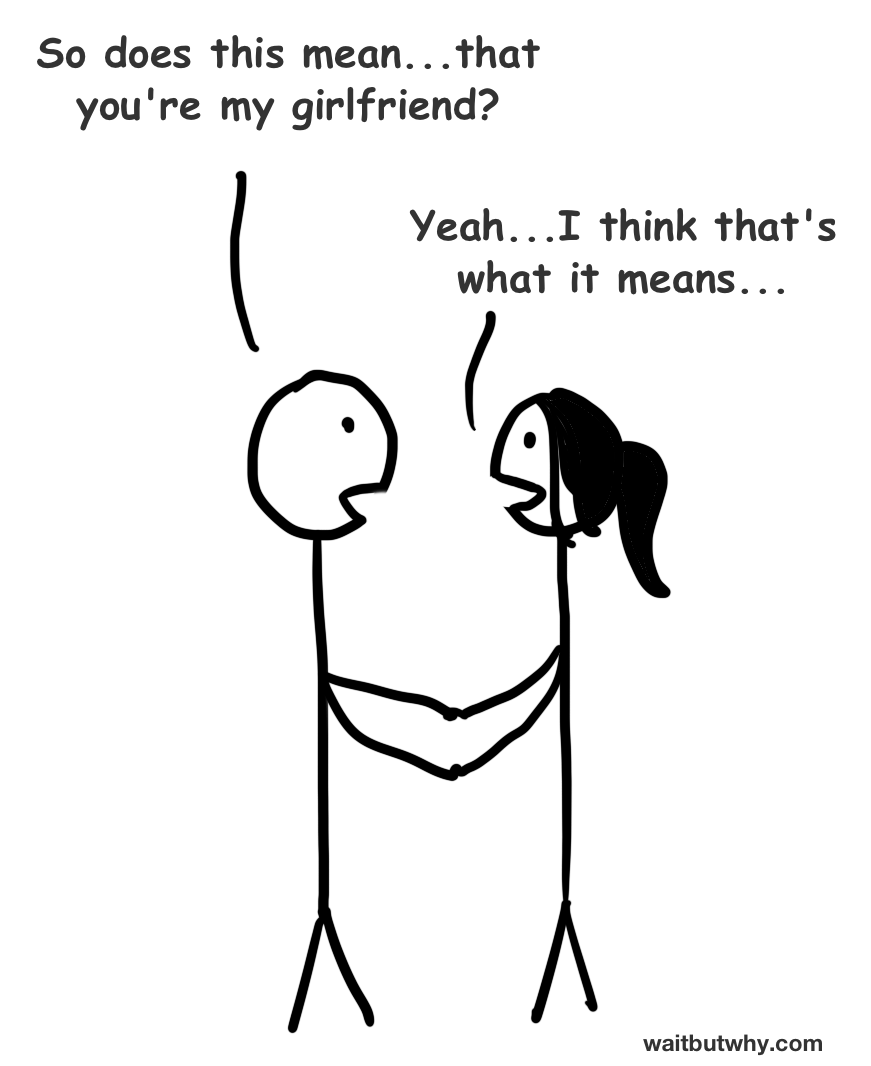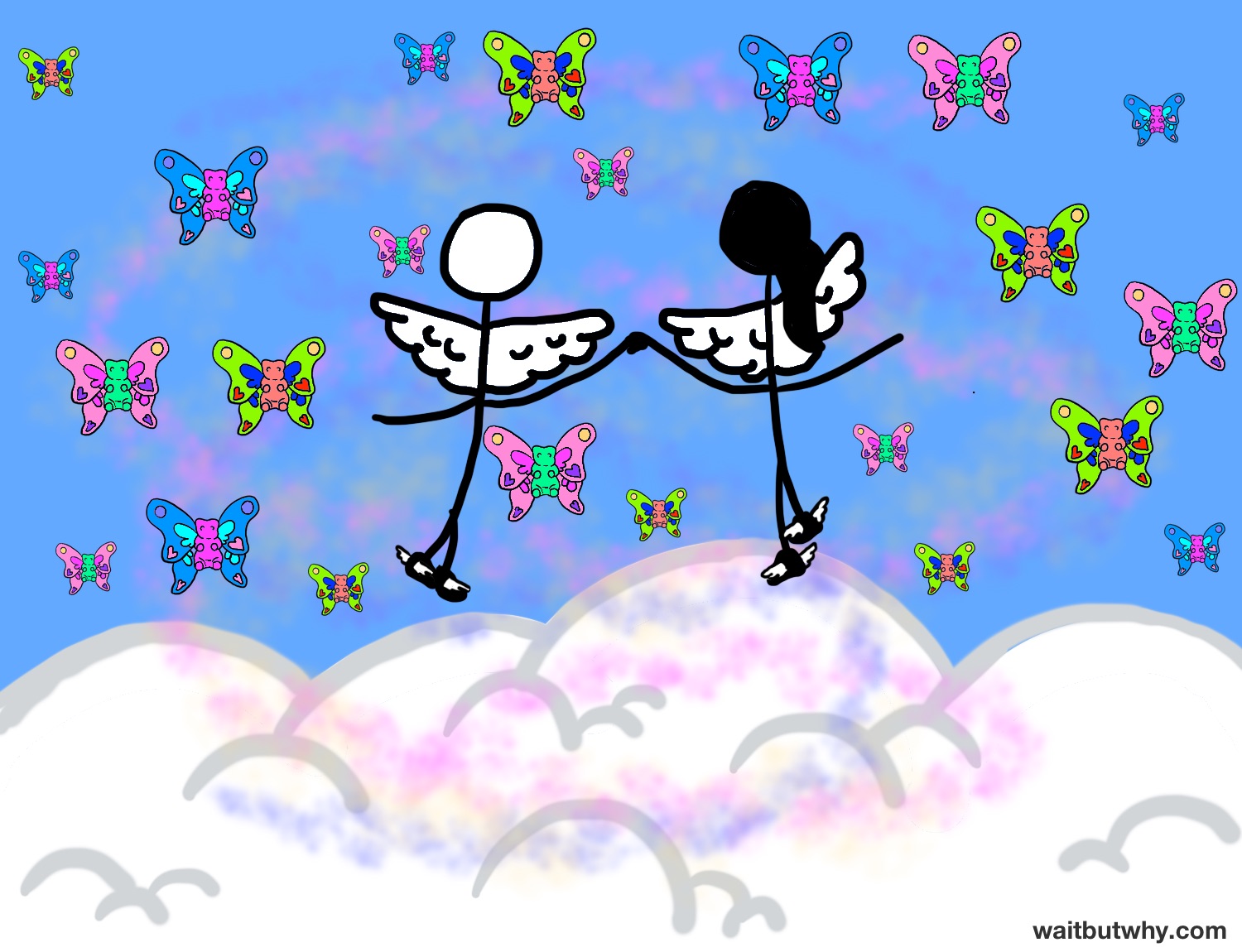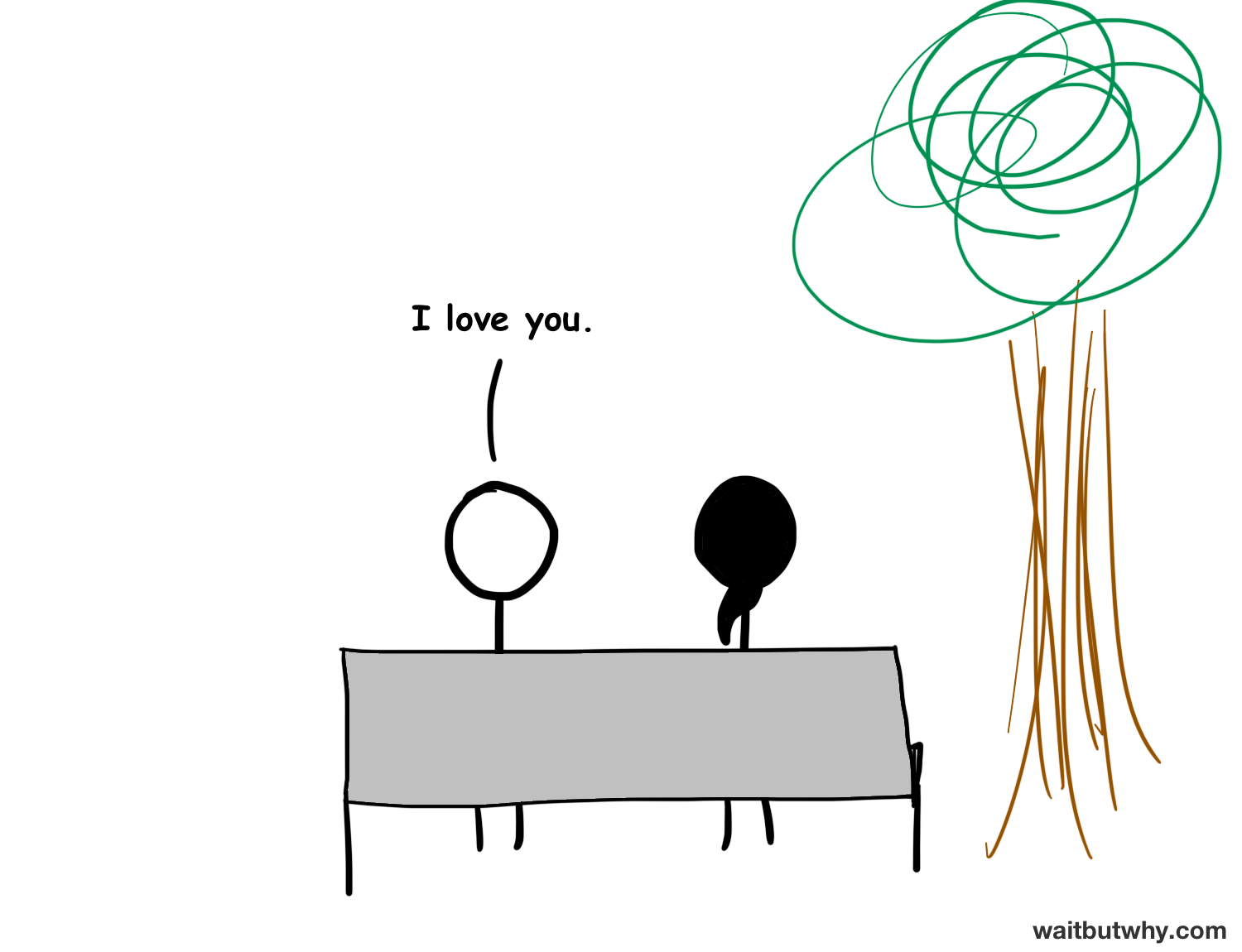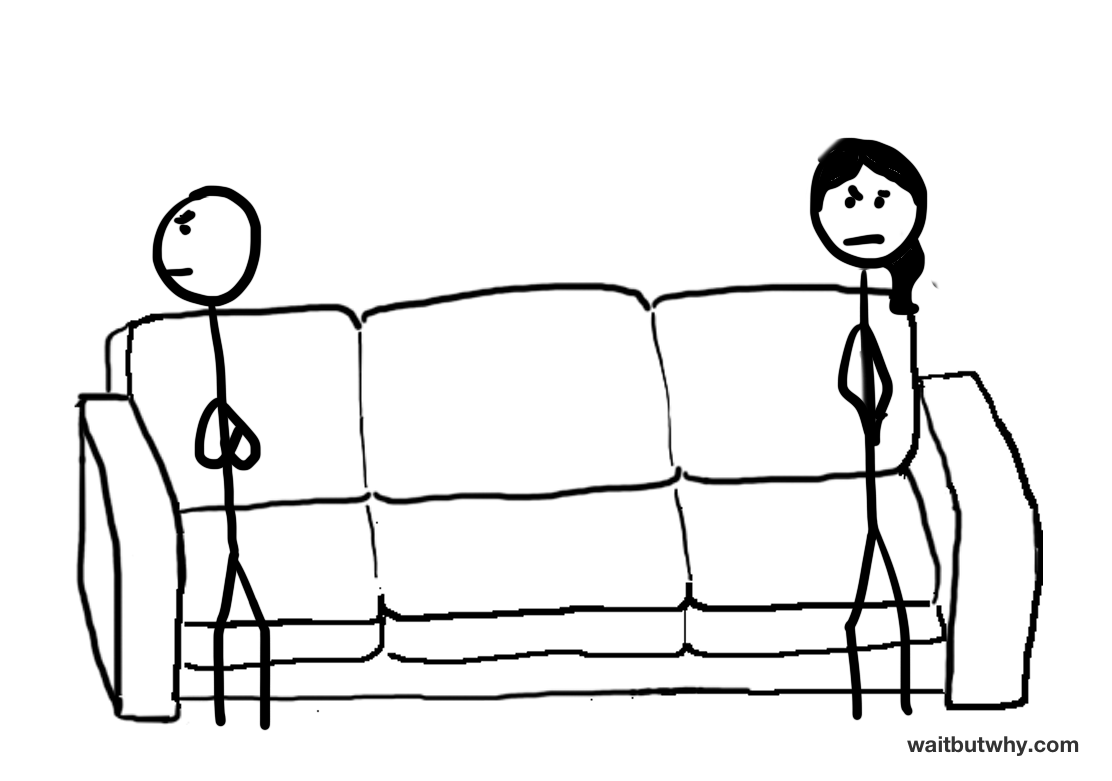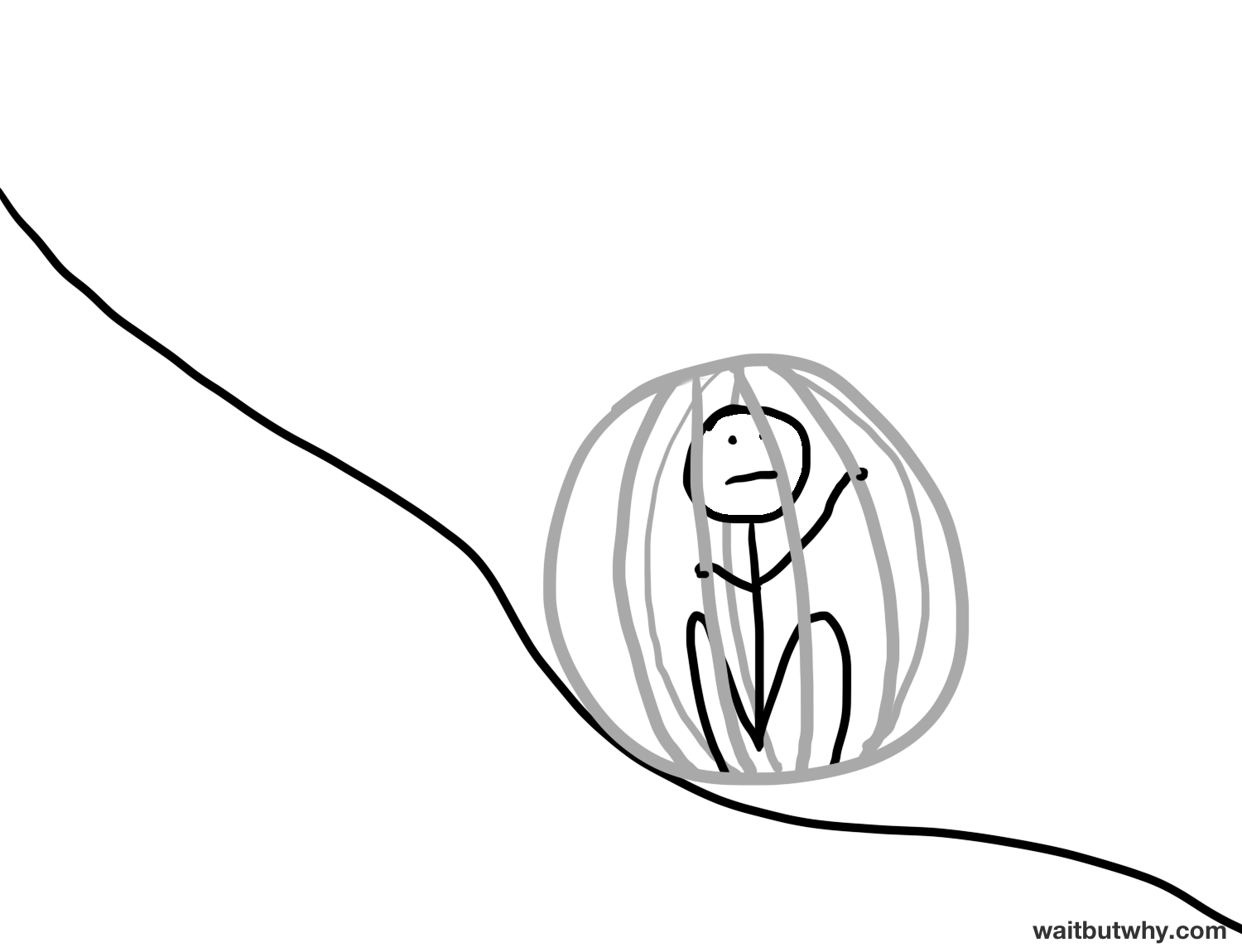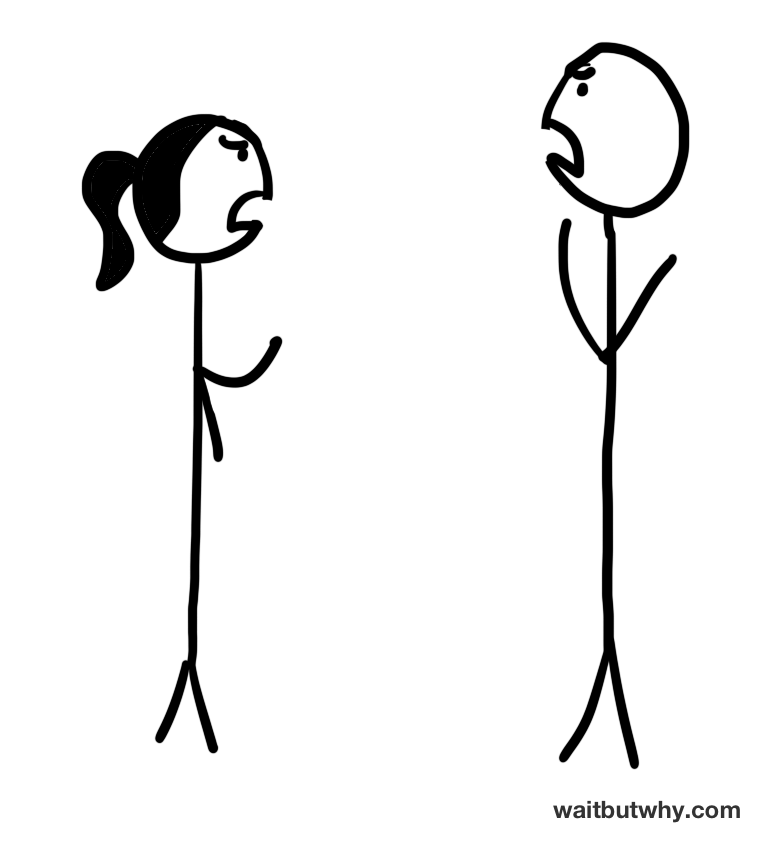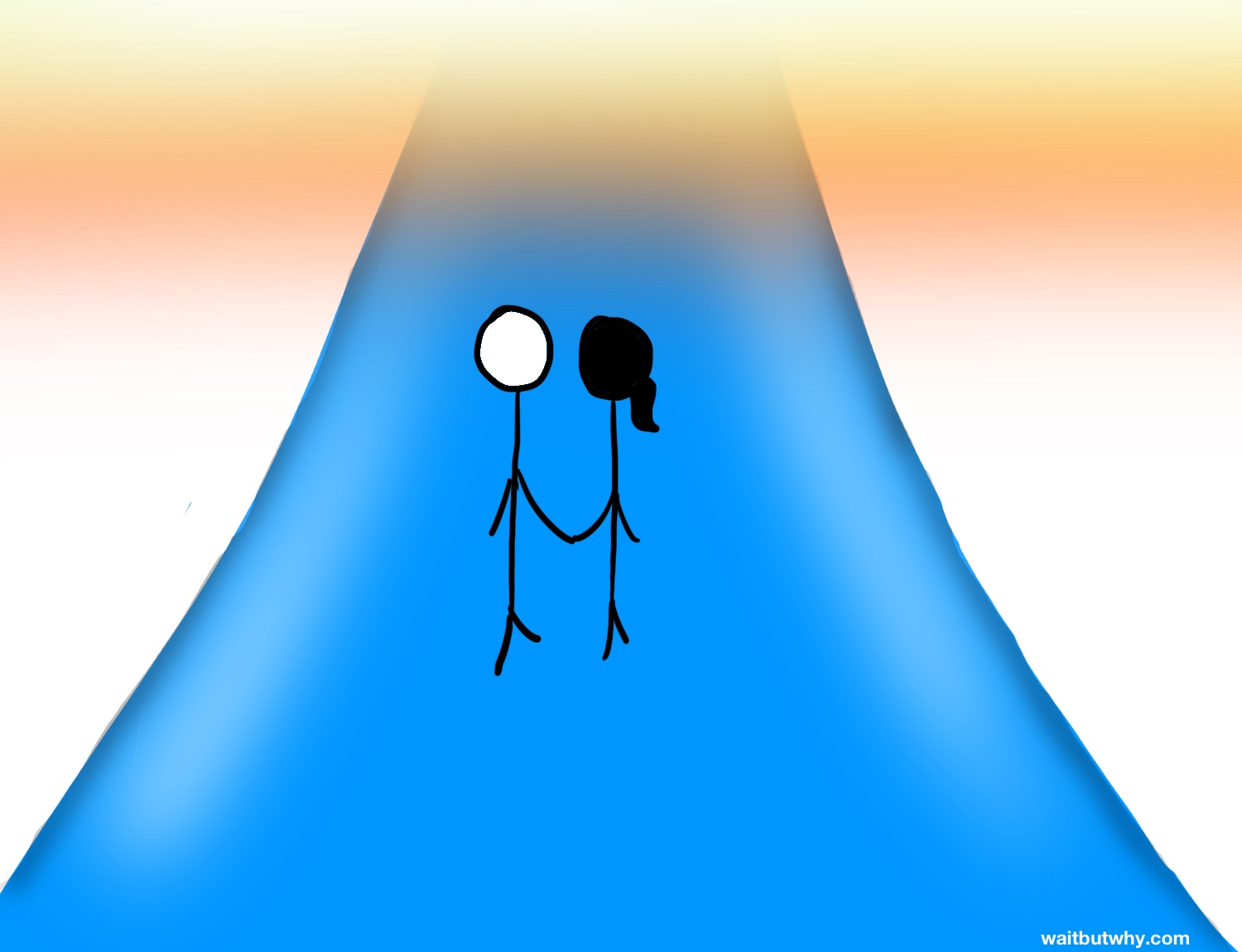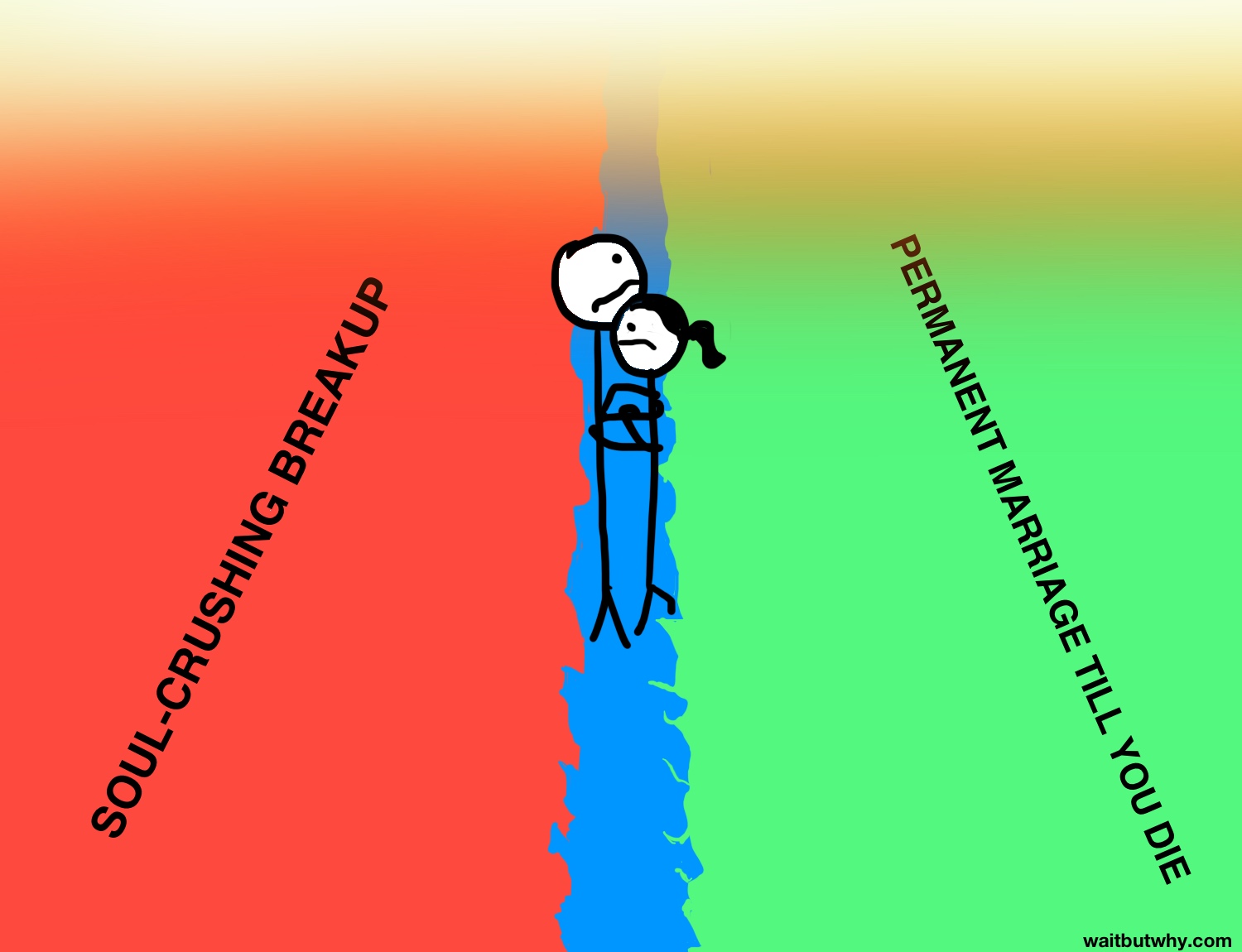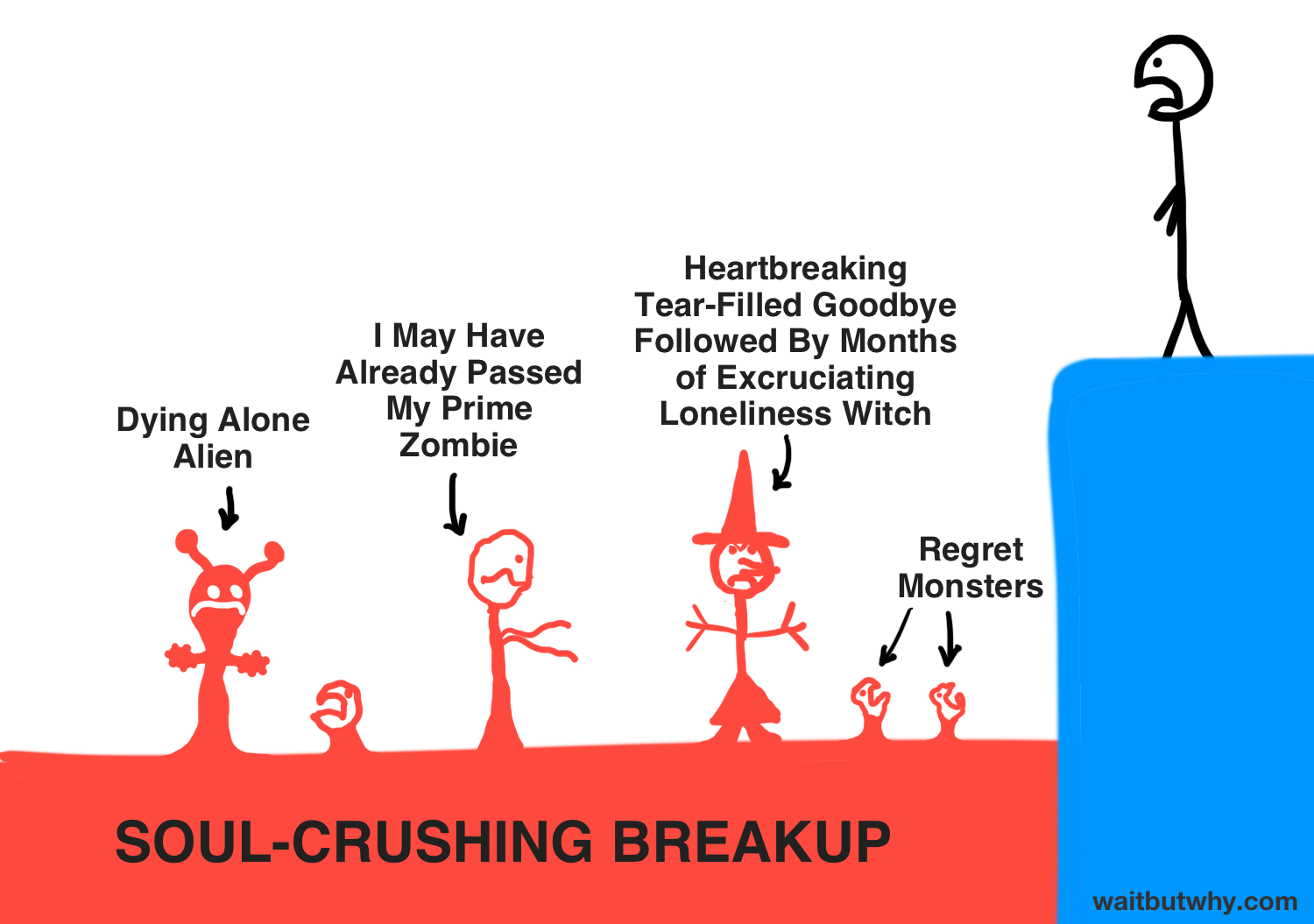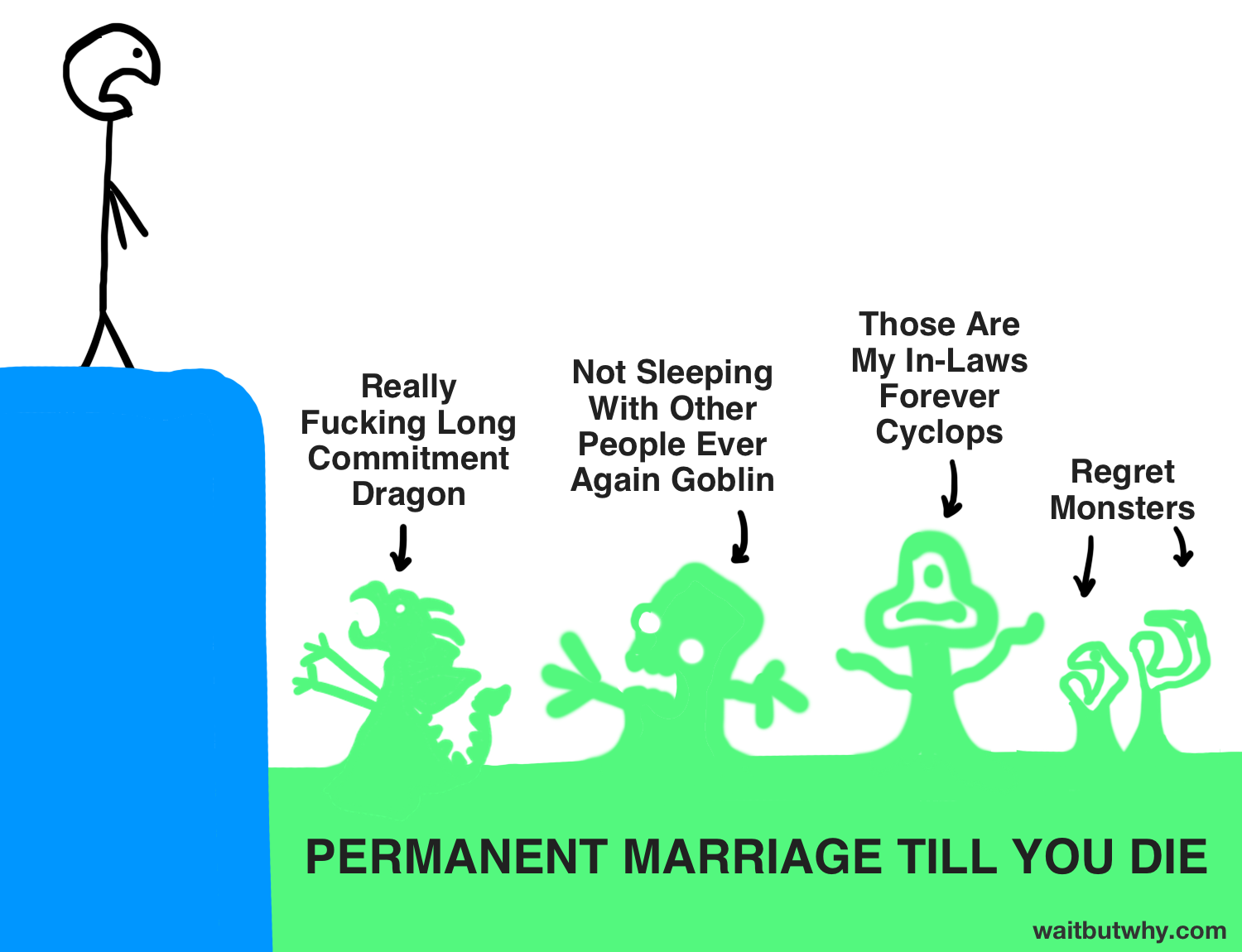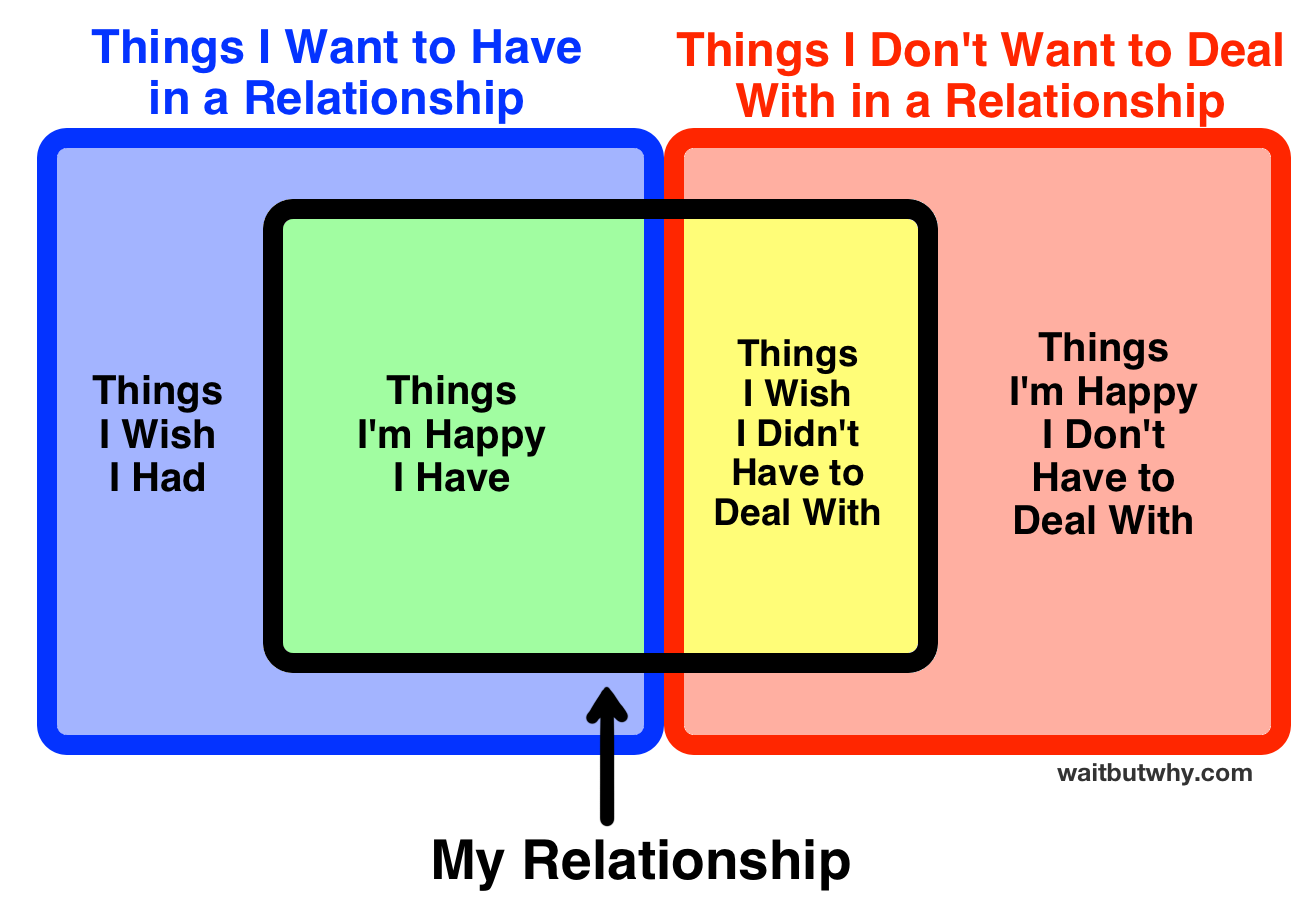There’s a normal way to start a relationship. Some people go on a date, and then another date, and then another, and one day it’s just clear to both of them that they’re in a relationship. Some people start seeing each other, but they keep things black and white until a “So are we doing this?” conversation makes it official. Sometimes, a platonic friendship forms first, and tension builds under the surface until an unexpected kiss lights the friendship on fire.
But there’s usually some first time that this happens:
And suddenly, you’re here:
Your new relationship is with you all the time, even when you’re not together.
You’ve left the rest of shitty humanity behind, and it feels great. Then this happens:
And all the song lyrics make sense.
It goes on like this for a while, but as the months pass, you notice things changing. The unicorns turn into horses and then bikes, and then one day, you’re not riding anything at all. The perfect person you found starts to say and do imperfect things. Some of those funny quirks you adored early on seem to be striking you as more annoying than funny. And it starts to dawn on you that you might be dating a fucking dick.
Sometimes things go further south, as butterflies and rainbows turn into frustration and disillusionment, and the relationship that used to lift you up seems to now be boxing you in.
All of the negative qualities you couldn’t see in the fog of love are suddenly right in your face, like a weight that’s dragging you down.
A lot of relationships end right about here.
But maybe, having seen the dark side of your partner, you step back and take a long look at both the good and bad together. You put away both the rose-colored glasses and the shit-colored glasses and see who you’re really dating: a three-dimensional, one-of-a-kind, beautiful, piece-of-shit human being.
Who’s the best?
And the worst.
And your teammate.
And you’re rock.
And you decide you like what you’ve got.
And your lives go on together.
But just when things get simple, something else starts to happen:
Society, in most parts of the world, doesn’t like when a relationship lasts too long. To society, a relationship is simply a testing ground—an incubator that prepares you for The Decision. And if too many years go by in a relationship without The Decision being made, society decides that something must be wrong. To help right the wrong, society will begin to apply pressure on the couple from all angles.
Some people are bigger than society. Most of us are not. For most of us, society’s rules are our rules, and as you and your person walk down your blue balance beam, you can feel the walking space melt away around you. It’s time to make The Decision.
Your relationship needs to be converted into Everything Forever or Nothing Ever Again. Soon.
The typical human isn’t equipped to make The Decision. We evolved to live short lives, during which life-altering 60-year commitments weren’t a thing. We evolved in small communities without nearly as many available options. And most of us, when presented with The Decision, have relatively little relationship experience and an incomplete understanding of our adult selves—selves that in many cases only recently started existing.
But society doesn’t care. So you decide.
Humans have come up with four main methods to make The Decision:
Method 1) Let the other person decide
The easiest way to handle The Decision is to just not handle it. You take a passive approach, as if you’re on a raft, going down a river, and you have no control over where the current leads you—you’re in the hands of momentum and inertia. Once you hit your mid-20s, you just wait until you get into your next relationship and then marry whoever that person happens to be, whenever/if-ever that person decides it’s time, regardless of how right or wrong the relationship is for you.
Method 2) Let your primal forces battle it out
For people determined to more actively make The Decision, the next easiest way to go is to let your emotions and primal forces figure it out. Making The Decision provides a reminder that “you” is a collection of voices, each weighing in from different parts of evolutionary history. Each voice has its role in the homeostasis of our normal lives, but when it’s time for something as rare and important as The Decision, there’s suddenly a brawl in your head for influence—and no one brawls harder than your primal forces. Some of the major players:
Love
Deep down, most people are sympathetic characters. And when you’re in a relationship for long enough, you’ll usually end up loving the person, even if you don’t like them. You know their whole story, which makes you care about them, and the fact that they rely on you makes you feel a tremendous loyalty to them. This is the kind of love you feel for your family and closest friends, and it can exist in full force even after the feeling of being “in love” has faded. And for many people, this deep emotional connection makes it basically inconceivable to ever break up with their partner. This is a beautiful way to make The Decision when you’re in a strong, healthy relationship, and a tragedy when you’re not.
Fear
Humans specialize in making critical life decisions based on fear, and when it comes to The Decision, there’s a lot to be afraid of.
When a fearful person looks to the left side of the balance beam, they might see all kinds of things:
The right side of the beam isn’t much better.
Different people feel these fears at different levels of intensity, and for someone whose fear tends to run their life, it’s usually pretty simple: the particular fear that grabs them hardest by the collar ends up making The Decision.
Ego
Your ego, meanwhile, is busy staring down at a clipboard. Depending on what your ego values, that clipboard might display a checklist describing your ideal partner—their appearance, age, family background, intelligence, job, wealth, general personality type, etc. Or maybe the clipboard has a story written on it, one that was written long ago about how your life should go. Your ego will examine your current situation and see how it measures up to what’s written on the clipboard, and it’ll base The Decision on its findings.
While all of this analysis is going on, your ego sometimes also finds itself getting very hungry—for admiration, attention, and conquest. If this hunger gets too intense, it can overwhelm an ego to the point where it may sway its vote, no matter what the clipboard says.
Sex Drive
Your sex drive is not a complicated character. If it has a grilled cheese sandwich every day for lunch and then one day, you ask it if it would like to try the buffet, it’s going to say yes. Unless, of course, the grilled cheese is super fucking incredible.
So these four primal forces, along with a few others, all voice their opinion at the same time. In some people, all of the voices are in agreement about the verdict. In others, the voices disagree, but one of the voices is so loud that it drowns out the others. In both of those cases, The Decision is pretty easy.
But what happens when your primal forces provide no clear answer?
Method 3) Turn to your gut
For some reason, we have wise stomachs, and when The Decision isn’t obvious, sometimes asking your gut can do the trick.
Your gut relies on your intuition and asks one simple question:
And what makes your gut your gut is that when it answers that question, it doesn’t deliberate—it just knows the answer: a simple yes or a simple no. The gut doesn’t deal with nuance, which makes it a good match for something big and binary, like The Decision.
And for a lot of people, this works.
But some people won’t end up being passive Deciders, or emotional Deciders, or gut Deciders—who won’t turn to any primal or instinctual voice when it comes to this particular decision. They’ll get to the bottom of this in spite of those voices, based on experience and evidence and data, and facts. They won’t be instinct-driven or fear-driven or ego-driven or sex-driven—they’ll be guided by rationality.
The brain Deciders.
And when it comes time for them to make The Decision, they’re in big trouble.
Method 4) Figure it out in your brain
The prefrontal cortex is kind of like the brain’s brain. It’s the part of you that sorts through information and makes plans and predictions and weighs evidence. It’s great at using what it learns to conclude how to act or what to do, as long as it knows the rules of the game and has access to the right information. And when it’s time for The Decision, your brain will do what it always does when confronted by a fork in the road—it’ll attempt to think and assess and analyze its way to the optimal rational answer.
Something as important and permanent as The Decision requires conviction, and conviction requires a source. No source of conviction, no Decision.
The source of the heart’s conviction is its love and care for the other person. The source of the ego’s conviction is its belief in its clipboard. Fear and sex drive derive their conviction from the obvious—fear and sex. The source of the gut’s conviction is an instinctive feeling that emerges from experience. And an inertia-y person gets their conviction from the conviction of someone else. Those sources are what allow people to make The Decision with relative ease.
The brain hears these voices, but it discredits their conviction in each case because the certainty emerges from what the brain sees as an irrational place. For the brain, the only respectable source of conviction is sound evidence.
And good luck with that.
If you’re typically a brain person, when it comes to The Decision, you want to try not to be you. Because the brain, for all its merits, does not do well in this situation, where the outcome is critical and evidence is hard to come by. Let’s look at how it might go:
Maybe you start by looking over to the marriage side of the balance beam, where you see a house.
That’s the house of life you’re about to sign up for. You enjoy your relationship, so you’re excited about what might be inside that house. But the house is also mysterious, because you don’t know what either you or your partner will be like as a spouse, or how either of you will grow or change in the future. Not much concrete evidence there.
So you turn and look over at the breakup side of the beam. You see a path, and a couple walking down it.
That road is whatever life you’d end up living if you were to move on from your relationship, and that’s the marriage you’d end up in. The marriage that might have been.
What kind of marriage would that be, and what adventures lie down that road? Maybe your life on that road would be much happier than whatever’s in that house on the other side, and maybe your current partner would end up happier somewhere else, too. Or maybe you’d look back and realize that you made the biggest mistake of your life. Without knowing anything about that other path, there’s no way to compare it to the house on the other side. Again, no real evidence.
So you take a closer look at the one thing you have actual information about: your current relationship.
You decide to make a big chart where you list all the things you like and don’t like about your relationship—a relationship-assessment chart. You end up here:
Fucking great—now what? All relationships—the good ones and the bad ones—have a chart that looks like that, with things in all four of those zones: blue, green, yellow, and red. And without much relationship experience or marriage expertise, you have no good way to evaluate whether your particular diagram looks as promising as you hope it does or whether there are red flags in it that you’re not seeing that will lead to major issues later. You try comparing your relationship to those that your friends are in, but it’s hard to know what goes on in other relationships, and each one is so complicated and unique anyway that it’s mostly apples and oranges.
Without any way to construct an airtight argument in either direction, you’re left feeling very little conviction about the situation. Because the stakes are so high, you become paranoid about making the wrong choice, and every time you think you might have an answer, you second-guess yourself.
The whole thing quickly becomes a mindfuck. You try talking yourself into feeling good about marriage by reminding yourself that every relationship has flaws and that marriage is all about acceptance, but then you realize that that’s also exactly how someone sounds when they’re talking themselves into settling for the wrong person. In both of those cases, the green and red zones of the diagram provide more than enough material to construct a full “why this is a great decision” argument. Likewise, if you wanted to play devil’s advocate and look at the reasons this might not be the right marriage for you, the blue and yellow sections of the diagram would make it easy, whether breaking up is a wise move or a foolish one.
And because the diagram and its four zones allow you to so effortlessly construct whatever convincing narrative you want to about your relationship and The Decision, you worry that anything that feels like conviction is just you falling for a narrative created by fear or ego or some other deep-down motivation.
Unable to come to a trustworthy conclusion, the brain person becomes a Paralyzed Pre-Marriage Relationship Person. A PPMRP has three options:
1) Procrastinate. Until you die, until your partner dies, or until your partner breaks up with you.
2) Turn back around and succumb to one of the primal forces. Maybe if you wait for a while, your fear of being single at 36 will overpower your dedication to rationality?
3) Come up with a decision-making litmus test that works.
Assuming you don’t find the first two options ideal, let’s talk about litmus tests.
The “actually works” part of option 3 is important because people often come up with decision-making litmus tests that don’t tell you anything.
also Read this, The power of prayer. you can heal yourself
“Still Trapped in the Matrix? Get the Truth They Don’t Want You to Know.”
👉 Instant download + weekly wake-up drops.
Every week, we drop powerful, unfiltered insights that expose the lies, break the system, and rewire your mindset.
This isn't motivation — this is mental warfare for freedom-seekers, rebels, and future millionaires.

